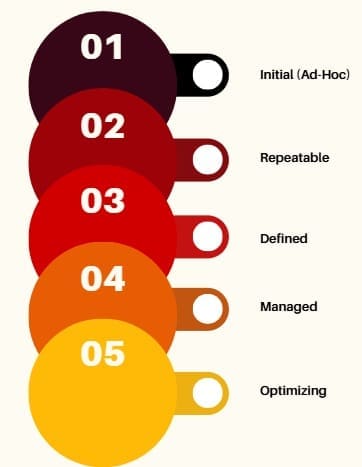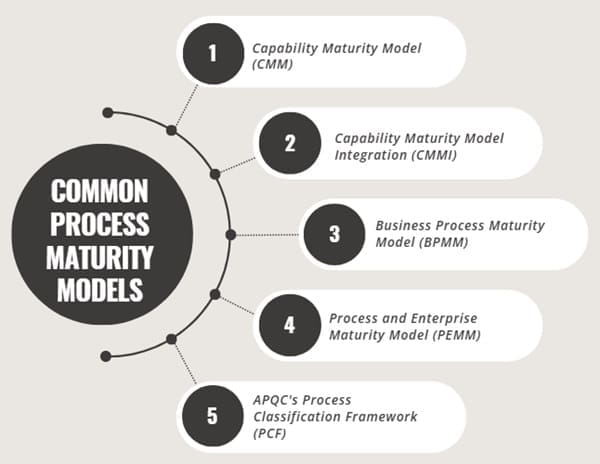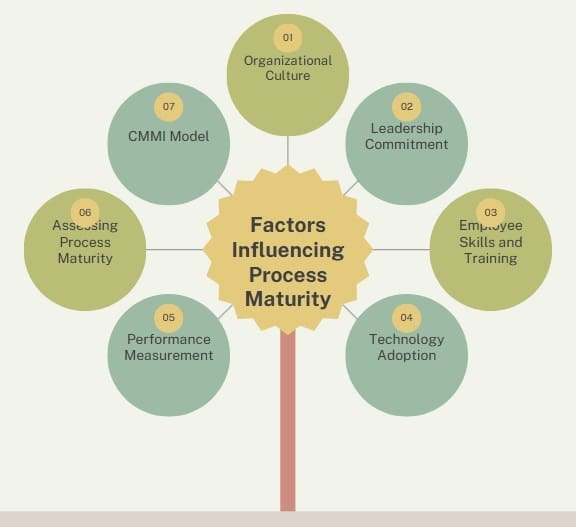Process maturity refers to the level of sophistication, standardization, and optimization within an organization’s processes. A mature process is reliable, consistent, and able to deliver value consistently. The ultimate goal is for organizations to continuously improve their processes and ensure they are capable of adapting to changing business conditions.
Achieving higher levels of process maturity can provide several business benefits, including increased efficiency, quality, and customer satisfaction.
In this guide, we will explore the concept of process maturity in depth, outlining its key components, the models used to assess it, and how organizations can implement strategies to enhance their process maturity.
Table of contents
What is Process Maturity?
Process maturity describes how well an organization’s processes are defined, managed, controlled, and optimized. It reflects how consistently and effectively processes contribute to organizational goals and customer satisfaction.
At its core, process maturity focuses on the predictability and effectiveness of processes. Organizations with high process maturity can deliver products and services that meet customer expectations consistently, while organizations with low process maturity often experience inefficiencies, errors, and unpredictable outcomes.
Initially, the concept of process maturity roots itself in the idea that organizations evolve through various stages of process development. Then, these stages progress from chaotic, ad-hoc processes to well-defined and optimized processes that organizations continuously improve.
Importance of Process Maturity

High process maturity brings numerous benefits to organizations, some of which include:
- Increased Consistency: Mature processes are predictable, which leads to more consistent results. This is essential for organizations that wish to provide reliable products and services to their customers.
- Improved Efficiency: By streamlining processes and removing bottlenecks, mature processes help organizations achieve better efficiency, reducing the time and resources required to complete tasks.
- Cost Savings: Mature processes help identify waste and unnecessary activities, leading to significant cost savings.
- Better Decision Making: With well-defined processes and performance metrics, organizations can make better, data-driven decisions.
- Enhanced Customer Satisfaction: Consistent processes ensure that products and services meet or exceed customer expectations, which boosts customer satisfaction and loyalty.
- Agility and Flexibility: Mature processes are easier to modify and adapt to changing business conditions. This enables organizations to quickly respond to market changes, customer demands, or regulatory requirements.
- Employee Satisfaction: When organizations clearly define their processes, employees can execute their work more effectively, consequently leading to increased job satisfaction and productivity.
Levels of Process Maturity

To understand process maturity, it’s important to recognize that organizations progress through different stages of development. These stages are commonly represented as levels in a maturity model. Below, we discuss the typical stages of process maturity, based on common frameworks used in various industries:
- Level 1: Initial (Ad-Hoc)
At this stage, processes are chaotic and unpredictable. Success is often dependent on individual effort rather than standardized procedures. There is little to no documentation, and processes are reactive rather than proactive. If something goes wrong, employees often scramble to find solutions. Organizations at this level often struggle with inefficiencies, errors, and inconsistent outcomes. - Level 2: Repeatable
In this stage, basic processes are established. These processes are often repeatable but not necessarily consistent across the organization. Documentation may be informal, and employees may follow best practices learned through experience. While there is more predictability, there may still be variation, and the focus is on managing specific activities rather than improving the entire process. - Level 3: Defined
At this level, processes are clearly defined, documented, and standardized across the organization. There is greater consistency, and employees follow well-documented procedures. Standardization leads to better efficiency, but there may still be opportunities for improvement. A key characteristic of this level is that the organization starts to focus on developing processes for better integration across departments. - Level 4: Managed
Processes are quantitatively measured and controlled at this stage. Data-driven decisions are made based on performance metrics, and process performance is regularly analyzed. The organization has systems in place to monitor and control processes to ensure they meet specific goals. There is an emphasis on process optimization, and improvements are made based on empirical data. - Level 5: Optimizing
At this stage, organizations quantitatively measure and control their processes. Furthermore, they make data-driven decisions based on performance metrics and regularly analyze process performance. There is a strong focus on innovation, with the organization constantly seeking ways to enhance efficiency, quality, and agility. The focus is on preventing problems before they occur and making processes even more effective.
Common Process Maturity Models

Several frameworks and models have been developed to help organizations assess and improve their process maturity. These models provide structured approaches that guide businesses through the stages of improvement.
- Capability Maturity Model (CMM)
The Software Engineering Institute (SEI) at Carnegie Mellon University developed the Capability Maturity Model (CMM) originally to improve software development processes. Subsequently, many other industries have widely applied its principles. CMM assesses organizations across five maturity levels, as discussed above. The CMM encourages organizations to move from an ad-hoc, chaotic environment to one where they measure, manage, and optimize their processes. - Capability Maturity Model Integration (CMMI)
Building on the original CMM, the Capability Maturity Model Integration (CMMI) is a more comprehensive model that covers multiple disciplines, including software engineering, systems engineering, and product development. CMMI provides a framework for organizations to improve performance across various functions. It encourages the integration of different processes and promotes continuous improvement. - Business Process Maturity Model (BPMM)
The Business Process Maturity Model (BPMM) focuses specifically on the maturity of business processes. It emphasizes the alignment of processes with organizational goals, ensuring that processes are designed to contribute to the overall business strategy. BPMM takes into account the importance of governance, process innovation, and technology integration in achieving process maturity. - Process and Enterprise Maturity Model (PEMM)
Developed by Dr. Michael Hammer, PEMM evaluates organizations on two main aspects: process enablers (such as leadership, culture, and governance) and process capabilities (such as strategy and process design). PEMM provides a holistic approach to process improvement, ensuring that organizations not only improve individual processes but also develop the capabilities necessary to sustain long-term improvement. - APQC’s Process Classification Framework (PCF)
The American Productivity and Quality Center (APQC) developed the Process Classification Framework (PCF) to help organizations define and assess their business processes. The PCF is a tool that identifies key business processes and offers guidelines for improving process maturity. This framework is widely used across various industries to benchmark processes and measure improvements over time.
Factors Influencing Process Maturity

Several factors affect process maturity. Organizational culture plays a role. Leadership commitment is essential. Employee skills and training are important. Technology adoption can help. Performance measurement drives improvement.
Organizational Culture
A culture of continuous improvement is key. Employees should be engaged in process work. Collaboration and communication are vital. Learning from mistakes should be encouraged.
Leadership Commitment
Leaders must champion process improvement. They need to provide resources and support. They should communicate the importance of maturity. Their actions should align with process goals.
Employee Skills and Training
Employees need the skills to follow processes. Training should cover process standards. They should understand improvement methodologies. Empowering employees drives ownership.
Technology Adoption
Technology can automate tasks. It can improve data collection. It can support process monitoring. Tools should align with process needs. Effective use enhances efficiency.
Performance Measurement
Metrics should track process performance. Data analysis identifies areas for improvement. Regular reviews monitor progress. Feedback loops enable adjustments.
Assessing Process Maturity
Organizations can assess their maturity. They use various assessment models. CMMI is a widely used model. Assessments identify strengths and weaknesses. They highlight areas for improvement.
CMMI Model
Capability Maturity Model Integration (CMMI) is a framework. It guides process improvement efforts. Further, it covers various disciplines. It provides a structured approach. It helps organizations achieve higher maturity.
Steps to Improve Process Maturity

Improving process maturity is not an overnight task. It requires a structured approach and a commitment to continuous improvement. Below are the steps organizations can take to improve their process maturity:
- Assess Current Processes
The first step in improving process maturity is to evaluate the current state of processes. This includes identifying strengths, weaknesses, and gaps in existing procedures. Process mapping and data analysis tools can help identify inefficiencies and areas for improvement. - Define Clear Objectives and KPIs
To improve processes effectively, it’s essential to define clear objectives and Key Performance Indicators (KPIs). These goals should be specific, measurable, and aligned with the organization’s broader business objectives. Defining KPIs allows organizations to track progress and determine whether their improvement efforts are successful. - Standardize and Document Processes
Standardization is a key component of process maturity. Once processes are defined, they should be documented and standardized across the organization. This ensures that all employees follow the same procedures, which reduces variability and improves efficiency. - Implement Performance Monitoring
Once processes are standardized, organizations should implement performance monitoring systems. These systems track process performance, identify issues, and provide data-driven insights that guide continuous improvement efforts. - Foster a Culture of Continuous Improvement
Achieving high levels of process maturity requires an organization-wide commitment to continuous improvement. This involves fostering a culture where organizations encourage employees at all levels to identify opportunities for process optimization and contribute to ongoing improvements. - Invest in Technology
Technology can play a critical role in improving process maturity. Automation, data analytics, and process management tools can streamline operations, improve efficiency, and provide real-time performance insights. - Provide Training and Support
As processes become more standardized and optimized, employees must be trained to execute them effectively. Providing training and ongoing support ensures that employees have the skills and knowledge needed to follow new processes and contribute to improvements.
Challenges in Achieving Process Maturity
While the benefits of process maturity are clear, achieving high levels of maturity can be challenging. Some common challenges include:
- Resistance to Change: Employees may resist new processes or systems, especially if they are used to old ways of working.
- Lack of Leadership Support: Achieving process maturity requires strong leadership to drive change and provide resources.
- Resource Constraints: Process improvement initiatives may require significant investment in terms of time, money, and personnel.
- Cultural Barriers: Changing the culture of an organization to embrace continuous improvement can be difficult.
Integrating Six Sigma with Process Maturity
Six Sigma methodologies (DMAIC, DMADV) are powerful tools for driving process improvement within a process maturity framework.
- Levels 1 & 2: Six Sigma can help define and stabilize key processes.
- Level 3: Six Sigma provides the tools for analyzing and improving standardized processes.
- Level 4: Six Sigma aligns perfectly with the focus on quantitative management and statistical control.
- Level 5: Six Sigma supports the continuous improvement and innovation efforts.
Final Read
Process maturity is crucial for organizations seeking long-term success in a competitive environment. By assessing current processes, setting clear goals, adopting maturity models, and committing to continuous improvement, businesses can enhance their operational efficiency, improve customer satisfaction, and achieve sustained growth.
The journey towards process maturity is not easy, but the rewards are substantial. By achieving higher levels of process maturity, organizations can gain a competitive edge, reduce costs, improve quality, and foster a culture of innovation and excellence.

About Six Sigma Development Solutions, Inc.
Six Sigma Development Solutions, Inc. offers onsite, public, and virtual Lean Six Sigma certification training. We are an Accredited Training Organization by the IASSC (International Association of Six Sigma Certification). We offer Lean Six Sigma Green Belt, Black Belt, and Yellow Belt, as well as LEAN certifications.
Book a Call and Let us know how we can help meet your training needs.



















